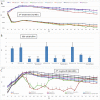EDTA and Taurolidine Affect Pseudomonas aeruginosa Virulence In Vitro-Impairment of Secretory Profile and Biofilm Production onto Peritoneal Dialysis Catheters
- PMID: 34787464
- PMCID: PMC8597648
- DOI: 10.1128/Spectrum.01047-21
EDTA and Taurolidine Affect Pseudomonas aeruginosa Virulence In Vitro-Impairment of Secretory Profile and Biofilm Production onto Peritoneal Dialysis Catheters
Abstract
Peritoneal catheter-associated biofilm infection is reported to be the main cause of refractory peritonitis in peritoneal dialysis patients. The application of antimicrobial lock therapy, based on results on central venous catheters, may be a promising option for treatment of biofilm-harboring peritoneal catheters. This study investigated the effects of two lock solutions, EDTA and taurolidine, on an in vitro model of Pseudomonas aeruginosa biofilm-related peritoneal catheter infection. Silicone peritoneal catheters were incubated for 24 h with a bioluminescent strain of P. aeruginosa. Then, serial dilutions of taurolidine and/or EDTA were applied (for 24 h) once or twice onto the contaminated catheters, and P. aeruginosa viability/persistence were evaluated in real time up to 120 h using a Fluoroskan reader. On selected supernatants, high-performance liquid chromatography mass spectrometry (HPLC-MS) analysis was performed to measure the production of autoinducers (AI), phenazines, and pyocyianines. Taurolidine alone or in combination with EDTA caused a significant decrease of bacterial load and biofilm persistence on the contaminated catheters. The treatment did not lead to the sterilization of the devices, yet it resulted in a substantial destructuration of the catheter-associated P. aeruginosa biofilm. HPLC-MS analysis showed that the treatment of biofilm-harboring catheters with taurolidine and EDTA also affected the secretory activity of the pathogen. EDTA and taurolidine affect P. aeruginosa biofilm produced on peritoneal catheters and profoundly compromise the microbial secretory profile. Future studies are needed to establish whether such lock solutions can be used to render peritoneal catheter-related infections more susceptible to antibiotic treatment. IMPORTANCE An in vitro model allows studies on the mechanisms by which the lock solutions exert their antimicrobial effects on catheter-associated biofilm, thus providing a better understanding of the management of devise-associated infections.
Keywords: Pseudomonas aeruginosa; biofilm; lock solutions; peritoneal dialysis catheters.
Figures




Similar articles
-
Relapsing peritonitis and taurolidine peritoneal catheter lock: One center experience.J Vasc Access. 2021 Mar;22(2):261-265. doi: 10.1177/1129729820937099. Epub 2020 Jun 30. J Vasc Access. 2021. PMID: 32605474
-
Comparison of taurolidine with 4% ethylenediaminetetraacetic acid on antimicrobial lock effectiveness: An experimental study.JPEN J Parenter Enteral Nutr. 2025 Apr;49(3):373-378. doi: 10.1002/jpen.2725. Epub 2025 Jan 26. JPEN J Parenter Enteral Nutr. 2025. PMID: 39865419
-
Biofilm formation in long-term central venous catheters in children with cancer: a randomized controlled open-labelled trial of taurolidine versus heparin.APMIS. 2012 Oct;120(10):794-801. doi: 10.1111/j.1600-0463.2012.02910.x. Epub 2012 May 15. APMIS. 2012. PMID: 22958287 Clinical Trial.
-
Taurolidine and Heparin as Catheter Lock Solution for Central Venous Catheters in Hemodialysis.Am J Ther. 2024 Jul-Aug 01;31(4):e398-e409. doi: 10.1097/MJT.0000000000001736. Epub 2024 May 7. Am J Ther. 2024. PMID: 38710029 Review.
-
Evidence-based criteria for the choice and the clinical use of the most appropriate lock solutions for central venous catheters (excluding dialysis catheters): a GAVeCeLT consensus.J Vasc Access. 2016 Nov 2;17(6):453-464. doi: 10.5301/jva.5000576. Epub 2016 Aug 1. J Vasc Access. 2016. PMID: 27516141 Review.
Cited by
-
A co-conserved gene pair supports Caulobacter iron homeostasis during chelation stress.bioRxiv [Preprint]. 2025 Feb 21:2024.10.16.618771. doi: 10.1101/2024.10.16.618771. bioRxiv. 2025. Update in: J Bacteriol. 2025 Apr 17;207(4):e0048424. doi: 10.1128/jb.00484-24. PMID: 40027609 Free PMC article. Updated. Preprint.
-
Persistent peritonitis in peritoneal dialysis: a comphrenesive review of recurrent, relapsing, refractory, and repeat peritonitis.Int Urol Nephrol. 2024 Feb;56(2):583-595. doi: 10.1007/s11255-023-03731-w. Epub 2023 Aug 10. Int Urol Nephrol. 2024. PMID: 37563501 Review.
-
Screening for nasal carriage of Staphylococcus (S.) aureus reduces the risk of S. aureus peritonitis in patients on peritoneal dialysis (PD).Int Urol Nephrol. 2025 May;57(5):1639-1648. doi: 10.1007/s11255-024-04309-w. Epub 2024 Dec 30. Int Urol Nephrol. 2025. PMID: 39738858
-
A co-conserved gene pair supports Caulobacter iron homeostasis during chelation stress.J Bacteriol. 2025 Apr 17;207(4):e0048424. doi: 10.1128/jb.00484-24. Epub 2025 Mar 14. J Bacteriol. 2025. PMID: 40084995 Free PMC article.
-
Attenuation of Pseudomonas aeruginosa Virulence by Pomegranate Peel Extract.Microorganisms. 2022 Dec 16;10(12):2500. doi: 10.3390/microorganisms10122500. Microorganisms. 2022. PMID: 36557753 Free PMC article.
References
-
- Htay H, Cho Y, Pascoe EM, Darssan D, Nadeau-Fredette A-C, Hawley C, Clayton PA, Borlace M, Badve SV, Sud K, Boudville N, McDonald SP, Johnson DW. 2017. Multicenter registry analysis of center characteristics associated with technique failure in patients on incident peritoneal dialysis. CJASN 12:1090–1099. doi:10.2215/CJN.12321216. - DOI - PMC - PubMed
-
- Al Sahlawi M, Wilson G, Stallard B, Manera KE, Tong A, Pisoni RL, Fuller DS, Cho Y, Johnson DW, Piraino B, Schreiber MJ, Boudville NC, Teitelbaum I, Perl J. 2020. Peritoneal dialysis-associated peritonitis outcomes reported in trials and observational studies: a systematic review. 2020. Perit Dial Int 40:132–140. doi:10.1177/0896860819893810. - DOI - PubMed
Publication types
MeSH terms
Substances
LinkOut - more resources
Full Text Sources
Medical

